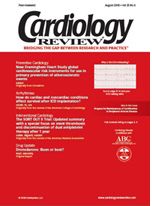Phase 3 study shows improvements in A1C and cardiometabolic risk factors in patients with type 2 diabetes
Diabetes
San Diego—In phase 3 clinical trials in patients with type 2 diabetes, the endocannabinoid antagonist rimonabant (Acomplia) lowered blood glucose levels, reduced weight and waist circumference, and improved the lipid profiles associated with diabetic dyslipidemia, according to data presented at the 65th Annual Scientific Sessions of the American Diabetes Association.
One-year data from a phase 3 study of 1,045 patients with type 2 diabetes who were receiving treatment with oral antidiabetic medications were presented by André Scheen, MD, head of clinical pharmacology, division of diabetes, nutrition, and metabolic disorders, Academic Hospital of Liège, Belgium, and principal investigator of the study, known as Rimonabant in Obesity (RIO)-Diabetes.
“The RIO-Diabetes trial results indicated that rimonabant delivered a clinically meaningful reduction in glycosylated hemoglobin [A1C] and may offer a broad range of cardiometabolic risk factor improvements that are essential for the comprehensive management of people with type 2 diabetes,” said Dr. Scheen.
RIO-Diabetes was a multicenter, randomized, double-blind trial in which two fixed-dose regimens of rimonabant (5 mg and 20 mg once daily) were compared with placebo for 1 year in patients with type 2 diabetes who had a mean waist circumference of 43.3 in. The patients were already being treated with either metformin or a sulfonylurea when they entered the study.
Compared with placebo, patients assigned to 20 mg/day of rimonabant achieved an A1C reduction of 0.7% (P < .001), from a baseline value of 7.3%. Forty-three percent of patients randomly assigned to rimonabant, 20 mg/day, and 21% of those assigned to placebo (P < .001) achieved an A1C less than 6.5%, a target set by the International Diabetes Federation and the American Association of Clinical Endocrinologists. Among those with a baseline A1C higher than 7.0%, which is the treatment goal set by the American Diabetes Association, 52.7% assigned to rimonabant, 20 mg/day, and 26.8% assigned to placebo (P < .001) reduced their A1C to below this goal by study’s end.
There was a mean weight reduction of 5.3 kg in patients treated with 20 mg/day of rimonabant versus 1.4 kg in the placebo recipients (P < .001). There was an average 1.3-in difference in waist circumference between the groups receiving rimonabant, 20 mg/day, and placebo.
High-density lipoprotein (HDL) cholesterol increased by 15.4% in patients treated with rimonabant, 20 mg/day, compared with 7.1% in the placebo group (P < .001). More than 50% of the improvement in HDL cholesterol levels was calculated to be beyond the improvement attributed to the weight loss achieved, said Dr. Scheen. Triglyceride levels were reduced by 9.1% in those assigned to rimonabant, 20 mg/day, whereas triglycerides increased by 7.3% in the placebo group (P < .001).
The proportion of patients meeting the criteria for a diagnosis of metabolic syndrome decreased by 18.9% of patients assigned to rimonabant, 20 mg/day, compared with a decline of 7.6% in the placebo group (P = .007).
Adverse effects of the 20 mg/day rimonabant treatment included nausea (12.5% versus 5.7% for placebo), dizziness (9.1% with rimonabant versus 4.9% with placebo), diarrhea (7.4% with rimonabant versus 6.6% with placebo), vomiting (5.9% with rimonabant versus 2.3% with placebo), hypoglycemia (5.3% with rimonabant versus 1.7% with placebo), fatigue (5.3% with rimonabant versus 3.7% with placebo), and anxiety (5.0% with rimonabant versus 2.6% with placebo). The rates of discon-
tinuation owing to adverse events across the entire phase 3 program of rimonabant were 13.8% in the group assigned to rim-onabant and 7.2% in the group assigned
to placebo.
